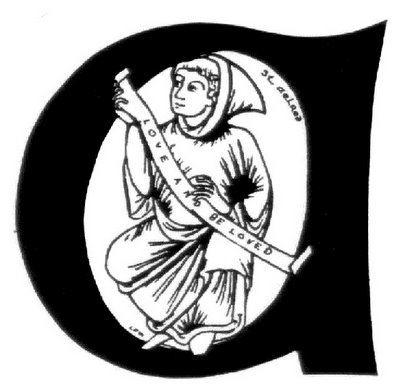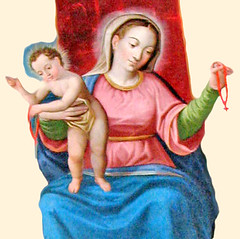St Aelred on Spiritual Friendship
 Today is the Feast of Saint Aelred, a Cistercian monk and abbot of Rievaulx Abbey in North Yorkshire from 1147 until his death in 1167. He was a contemporary of St Bernard of Clairvaux and he ruled the now-ruined abbey at a time of its spiritual and material wealth. Indeed, the Benedictine historian Dom David Knowles calls St Aelred the 'Bernard of the North' and says he "is a singularly attractive figure whom... we can see as a living man in some completeness. No other English monk of the twelfth-century so lingers in the memory... he escapes from his age, though most typical of it and speaks directly to us... of his restless search for One to whom he might give the full strength of his love" (The Monastic Order in England, p240).
Today is the Feast of Saint Aelred, a Cistercian monk and abbot of Rievaulx Abbey in North Yorkshire from 1147 until his death in 1167. He was a contemporary of St Bernard of Clairvaux and he ruled the now-ruined abbey at a time of its spiritual and material wealth. Indeed, the Benedictine historian Dom David Knowles calls St Aelred the 'Bernard of the North' and says he "is a singularly attractive figure whom... we can see as a living man in some completeness. No other English monk of the twelfth-century so lingers in the memory... he escapes from his age, though most typical of it and speaks directly to us... of his restless search for One to whom he might give the full strength of his love" (The Monastic Order in England, p240).St Aelred ruled a huge community of monks and an abbey that was a jewel in the Cistercian crown. In 1132, this community numbered only 25 but rose to 650 brothers by 1165! Such an influx of monks is credited to St Aelred who saw Rievaulx as a refuge for sinners and a place of salvation. As such his biographer said of him: "All (he said), strong and weak alike, should find in Rievaulx a haven of peace, a spacious and calm home... hence there came to Rievaulx from foreign nations and distant lands a stream of monks who needed brotherly mercy and true compassion, and there they found the peace and sanctity without which no man can see God" (Vita Ailredi, 96-97).
Unsurprisingly then, one of St Aelred's favourite passages from Scripture is: "Behold how good and how pleasant it is, brothers living together in unity" (Ps 133:1). Thus in his 'Mirror of Charity' he comments: "The day before yesterday, as I was walking the round of the cloister of the monastery, the brethren were sitting around forming as it were a most loving crown. In the midst, as it were, of the delights of paradise with the leaves, flowers and fruits of each single tree, I marveled. In multitude of brethren I found no one whom I did not love, and no one by whom I felt sure I was not loved. I was filled with such joy that it surpassed all the delights of this world." This vision of friendship which Aelred saw and lived out in Rievaulx no doubt contributed to his view of the abbey and the monastic life as a garden of friendship and love.
As such, his other classic writing is on 'Spiritual Friendship'. Together with the 'Mirror of Charity', these are unique works on love and friendship. There is no escaping the fact that St Aelred was a unique individual and his writings have a strong autobiographical note and have the sort of sensuality and poetic imagery that is typical of its era. As such, Brian Patrick McGuire writes in 'Friendship and Community: the Monastic Experience 350-1250' that Aelred's 'Spiritual Friendship' is "the distillation of Aelred's life experience into a set of rules for friendship, according to the twelfth-century conviction... that such a human bond can be regulated by certain norms. These limitations would, in Aelred's mind, safeguard monks who wanted to integrate everything in their daily lives into the love of God. Aelred was convinced that loving one's fellow human beings and choosing among these loves a few individuals as friends could help the monk (or any Christian) to the love of God" (p297).

The truly startling and yet attractive core of Aelred's convictions is that he "envisaged a continuous movement, from physical loves to those of the mind and heart and thence to the threshold of God" (ibid, p298). As such, it does not come as a surprise that St Aelred often quoted the Song of Songs, and sometimes in rather unlikely situations, such as the Finding of the Jesus in the Temple. Unlike St Augustine, who first enunciated the basic human need to love and be loved in return, and who saw a gap between love of neighbour and love of God, for St Aelred there is no gap. As McGuire explains, "In advancing from love to love we advance even closer to God, in whom we become one with our friends... because God is also friendship, loving the friend in the context of the community means also loving God."
There is evidence that for much of his life as a monk, St Aelred struggled with chastity and it is believed that many of the extreme austerities he undertook in order to "keep the fires of his body at such a low point" so that he would not give way to sins of the flesh led to a degradation of his health and his eventual death. But it is vital to note that for St Aelred, such austerities were necessary and good in order to maintain chastity and purity, those virtues essential to a monk and to growth in holiness. Rather like St Augustine but perhaps even more explicitly, St Aelred gives his readers a "first-hand view into the fires and passions that had most consumed him before they became spiritualized" (op. cit., McGuire, p300). But although Aelred "condemned genital sexuality as sinful and vicious", we ought to note that unlike St Augustine, Aelred "still believed in tenderness, affection and touching, and in being open and talking intimately about one's personal life. At the same time he did not feel pain or guilt for appreciating physical beauty in other human beings. Beauty was worth seeking so long as the pursuit did not lead to sin, for an attractive human being can also be virtuous and thus increase one's virtue. Instead of being afraid of the impulse within himself, Aelred by the end of his life, when he completed his 'Spiritual Friendship', became convinced that he could use his attraction towards others to become spiritually closer to other human beings and thus closer to God" (ibid, p303ff).
There is much that St Aelred offers to us in his insights and writings, especially on how it is possible and indeed, good and desirable to channel one's "sexual energy to spiritual fire". It is in such a light that Ronald Rolheiser once described Mother Teresa as a most erotic person; she loved truly and intensely. I have already mentioned that a key part to Aelred's conversion of his sexual energies was asceticism and he was certainly aware of the need to struggle constantly and vigilantly in order to maintain chastity. This is an important consideration because for some it seems as if the saints were asexual or simply prayed and were given the 'grace of chastity'. St Aelred's autobiographical account details the struggle with chastity which I suspect is true for many more religious down the ages. However, it is just as important to note that St Aelred "disregarded 'apatheia' or passionlessness as a goal in itself and insisted that love could be pure. Since human relationships concerned with either physical desire or hope of gain did not deserve the name of friendship, 'amicitia' by definition remained untouched by the sins of the world. In striving for true friendship, the monk was necessarily seeking God and the presence of God in those he came to love" (ibid, p307). As such, in his 'Spiritual Friendship', the abbot of Rievaulx argued that the progression from human to divine friendship was both natural and inevitable and he encouraged friendship in the monastery as a good worth pursuing and rejected the counter-argument that it was a danger to the solidarity of the community. Unlike later religious communities and seminaries which warned against 'particular friendships', St Aelred encouraged one to have friends in the community because these led one to love the whole community.

Interestingly, fr Timothy Radcliffe, OP in his excellent chapter on chastity and love in his latest book, 'What is the Point of Being a Christian', reflects upon the traditional caution against 'particular friendships' and also quotes St Aelred. The former Master of the Order of Preachers writes:
"St Aelred, the twelfth-century abbot of Rievaulx, warned religious against 'a love that in addressing itself to all, reaches no one'. Drawing near to the mystery of love will also mean that we shall love particular people, some with friendship, some with deep affection, and maybe some more passionately. We must learn how honestly to integrate these loves into our identity. I am told that in the past religious were often warned against 'particular friendships'. Gervase Matthew OP always said that he was more afraid of 'particular enmities'!"
In encouraging friendships, Aelred drew upon his Cistercian tradition and his own experience. There is evidence in his writings of his close friendships with fellow monks of Rievaulx. As McGuire writes, "Aelred trusted in the experiences contained in autobiography, history, Scripture and the classics... He sought and found God in the impulses of his own heart and in the experience of men whom he knew through his reading or daily contacts..." (op. cit., p322f). From these sources, Aelred shows the possiblility of an ascent from one form of friendship to another so that friends "may, with purer affections, mount to loftier heights." Commenting on these writings, David Knowles can thus say that "[Aelred's] unique position as a writer - wholly unique in England, and without exact parallel abroad - is due in part to the limpid sincerity with which he laid bare, in his wish to help others, the growth and progress of his own mind and heart, from the human to the divine..." (op. cit., p265) such that, rather like a medieval Henri Nouwen, he shows us that by God's grace and love, holiness is attainable.
Of the last great friendship of his life, with a young monk from France, St Aelred said: "Was it not a foretaste of blessedness thus to love and to be loved?" And clearly, he could say this because "as ever, he saw the pathway from human to divine love as clear and uncluttered. The love Aelred had for the brethren at Rievaulx, his special love for his subprior, and his love of God merged to provide him with a sense of the love for which he yearned in heaven, where all would be his friends in loving God" (op. cit., McGuire, p316).
Lest all this seem rather idealistic or even impossible, Aelred's writings are also full of warnings and experiences of friendships which fail and fade. Indeed, he warns about "how friendships can sour, how it can turn into physical desire, lead to misunderstandings and hatreds, and bring tears as well as joy. For all his sensitivity and delicacy, Aelred was a man of the world who knew about hatred and jealousy, fights and divisions. Daily he felt the impulses of his own flesh." Over and above the world - he was was once a courtier of the Scots king - he had chosen the monastic quiet of Rievaulx. But even though "[there] too he found divisive factions, jealous monks and troubled souls... he never gave up his pursuit of a new form of noble monastic culture where friendship was allowed a central role in bringing men together in the common pursuit of the one eternal friend, Jesus" (ibid, p327).
And ultimately it is Jesus who is the goal of all St Aelred's longings and ours. However, Aelred's writings and meditations on the Lord are extraordinary. As McGuire notes, Aelred writes about his love of the Lord "on a spiritual level in an atmosphere heavy with the scent of a beautiful body and warm kisses... As he made clear in the 'Mirror of Charity', we must seek to concentrate on the flesh of Jesus the drives that otherwise would be directed towards the flesh of other men. One great passion took over and consumed all others..." In discussing St Aelred, there is perhaps no avoiding the fact that he was "fascinated with male beauty and with youth" but the fact remains that "the attraction he felt towards other men he was eventually able to gather into an all-embracing love culminating in the love of God". Moreover, we must stress again, Aelred's revulsion of unchastity and the mortifications he endured for love of God: "He sought to integrate all the facets of his being into love without any sexual activity, which he considered to be a form of carnal concupiscence" (ibid., pp327ff). Thus, he offers to those Catholics who are afflicted with same-sex attraction, an example and model of spiritual friendship, fully in line with the teaching of the Catechism of the Catholic Church, such that "in Aelred's definition of true friendship, as in his life experience, sexual contact and spiritual love cannot be combined" (ibid., 332).
Finally, as the abbot of Rievaulx died of illness on 12 January 1167, he gazed at the Crucified Lord on the Cross and said: "Thou art my Lord and my God, thou art my refuge and my salvation, thou art my glory and my hope forever. Into thy hands I commit my spirit." And so he returned to Jesus, his Friend and the Love of his life.

How are we to sum up St Aelred, whose feast the English Church marks today, promulgated by the Cistercians in 1476? Dr McGuire perhaps summarises his life and also his model of sanctity in the best way: "In his time and in our day, Aelred remains a controversial figure, simply because he insisted on loving and being loved, on being disciplined and being free, on giving to and taking from others, and in combining everything in God and man in one complete dynamic of love. Sensitive man, dedicated monk, devoted abbot, true friend - and source for scandal as Jesus himself had been in his time - Aelred sought and gained in his own lifetime the friendship without which he could not live. He combined loving other men with loving God in the human and approachable Jesus to whom he reached out in his community of love..." (op. cit., p338).
More than ever today, the Church needs St Aelred's teaching and example and intercession that all Christians may learn that path of love he called 'spiritual friendship'; a true friendship that leads to God.
The photos above are of the ruins of Rievaulx Abbey; the ultimate one being of the Chapter House which St Aelred himself designed and where he was initially buried until his transfer into the abbey church. Sadly, as with almost all the English monastic sites, Henry VIII's dissolution dispersed the Shrines and left the monastery in ruins.







6 Comments:
so how does this relate to the vatican's documents on priests and homosexuality?
Andrew: When you've read the 'Spiritual Friendship' and the 'Mirror of Charity', I'm sure you can answer that question yourself. The books are personal treatises on attaining an intimate union with Jesus Christ through chaste and Christian friendships.
In so far as one cannot with any accuracy say that St Aelred was "homosexual", then I don't see how we can find any real sort of relation...
The problem for us today is that there is a tendency to see the love between two men as necessarily homosexual. As such, we play into the hands of the 'gay' propagandists who accuse Jonathan and David and even Our Lord and St John as having had such relationships. Fie!
In fact, Aelred is part of a long monastic tradition of all male friendships in monastic communities dating from the 4th century... while he may have struggled with maintaining his chastity and is most candid in recounting these struggles, we should be thankful for the heroic example and witness he gives to overcoming his temptations and his love of Christ above all pleasures.
Hence, he is declared a saint of the Church, whose heroic example is held out for all to emulate at some level.
I'd be interested in reading St. Aelred's works, but the commentary you cite does seem a little creepy to me. "[He] believed . . . in touching"? Urg.
The commentary by Dr McGuire is in the 'Cistercian Studies' series, commissioned and published by the Cistercians in the USA.
It seems rather creepy to me that one should consider "touching" another human person to be 'urg'-worthy! Perhaps I have misunderstood you? What do you object to or find creepy in the commentary?
We ought to remember that we are bodily creatures and that touching, or quite simply contact with another person is a good and natural part of being human and of embodiment.
As St Paul reminds us, we are men and not angels. As such, all that is good and natural to the human state is also good for us. This includes physical contact with another person as a mark of friendship and balanced affectivity.
In the Philippines, touching is such an important part of life and culture that there are over 20 words for it, describing different ways and parts of the person that are touched.
We ought to ask why we should have an aversion to touching or why we find such language creepy... Are we perhaps prey to a certain hermeneutic of suspicion?
John Paul II, in his exposition on the 'Theology of the Body' says that when concupiscence holds sway in our heart, we will then project the same onto others and believe that the human body will always rouse concupiscence... But redemption and an anti-Manichean attitude would hold that it is possible in Christ to touch and behold another without fear of concupiscence.
St Aelred seems to have attained such a state of purity and that should be our goal too.
Thank you for your comment and I hope you manage to get hold of some of St Aelred's writings. Oh and maybe, read the Song of Songs in the Scriptures and don't allegorise it... And then tell me how people can say that we Christians deny or hate the body?!
I think I was simply reacting to the tone of some of the commentary, which I perceived as too PC. We have a lot of controversy about this kind of thing in the States; I don't know what it's like in Britian or the Phillipines. For instance, the program "Talking about Touching" endorsed by some church leaders for teaching children about abuse met with objection from some conservatives who pointed out that it was developed by Planned Parenthood type architects of the Culture of Death. This kind of thing, even if I only read about it on St. Blog's, puts a bad taste in my mouth for words like "touching," which seem to indicate too much of an interest in something which should be a natural part of life, as you said. In my family, we snuggle and kiss cute little babies, and tickle my little sister even though she adamantly claims not to be ticklish. Nothing beats a hug when a friend has relationship troubles or just a bad day . . . so I'm not creeped out by the nature of human affection (I am human, I love my friends and family) as much as by some of the language overtones, as least the way they sounded to me.
With that particular citation, for instance, the context is St. Aelred's rejection of "genital sexuality." To say that he still accepts other forms of "touching" implies other things to me than patting somebody on the back or giving a friend a hug when you meet them. Perhaps this comes from reading too much societal commentary on St. Blog's, and developing the "hermeneutic of suspicion" you mention?
I see your point. Mea culpa, as the editing of McGuire's text and the way it appears on the blog is my choice. The context that is intended is Aelred's distinction from St Augustine and also how his thinking is a development of Augustinian sources.
I added the fact that St Aelred was against sexual impurity because I did not want people to think that he was permissive or that he encouraged touching and hence sexual impurity!! Quite the opposite of how you read into it.
I hope this clarifies matters.
Post a Comment
<< Home